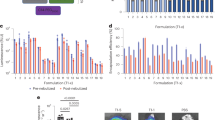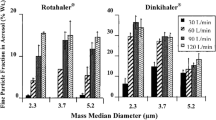ABSTRACT
Purpose
Conditions such as lung cancer currently lack non-invasively targetable and controlled release topical inhalational therapies. Superparamagnetic iron-oxide nanoparticles (SPIONs) have shown promising results as a targetable therapy. We aimed to fabricate and test the in-vitro performance of particles with SPION and drug within a lipid matrix as a potentially targetable and thermo-sensitive inhalable drug-delivery system.
Methods
Budesonide and SPIONs were incorporated into lipid particles using oil-in-water emulsification. Particles size, chemical composition, responsiveness to magnetic field, thermosensitiveness and inhalation performance in-vitro were investigated.
Results
Particles of average diameter 2–4 μm with budesonide and SPIONs inside the lipid matrix responded to a magnetic field with 100% extraction at a distance of 5 mm. Formulations were shown to have accelerated rate of drug release at hyperthermic temperatures (45°C)—controlled release. The produced inhalation dry powder presented promising inhalation performance, with an inhalable fine particle fraction of 30%.
Conclusions
The lipid system presented thermo-sensitive characteristics, suitable for controlled delivery, the model drug and SPION loaded lipid system was magnetically active and movable using simple permanent magnets, and the system demonstrates promise as an effective drug vehicle in targeted and controlled inhalation therapy.











Similar content being viewed by others
Abbreviations
- ABST:
-
acrylonitrile butadiene styrene thermoplastic
- AFM:
-
atomic forced microscopy
- DPI:
-
dry powder for inhalation
- DSC:
-
differential scanning calorimetry
- EDX:
-
energy-dispersing X-ray analysis
- HPMC:
-
hydroxypropyl methylcellulose
- Lip-Bud:
-
budesonide containing lipid microcapsules
- Lip-Bud-SPION:
-
budesonide and SPION containing lipid microcapsules
- Lipid:
-
glyceryl behenate (Compritol 888)
- logP:
-
partition coefficient
- SEM:
-
scanning electron microscopy
- SIOS:
-
scanning ion occlusion sensing
- SPION:
-
superparamagnetic iron-oxide nanoparticles
- XRD:
-
X-ray diffraction
REFERENCES
Lubbe AS, Alexiou C, Bergemann C. Clinical applications of magnetic drug targeting. J Surg Res. 2001;95(2):200–6.
Organization, W.H., Cancer, in Fact sheet N°297. 2009.
Silvestri GA, Alberg AJ, Ravenel J. The changing epidemiology of lung cancer with a focus on screening. Br Med J. 2009;339(b3053):451–4.
Limited TG, Therapeutic Guidelines: Respiratory. Therapeutic Guidelines, ed. T.G. Limited. Vol. 3. 2005, Melbourne. 210.
Martin AR, Finlay WH. Alignment of magnetite-loaded high aspect ratio aerosol drug particles with magnetic fields. Aerosol Sci Technol. 2008;42:295–8.
Martin AR, Finlay WH. Enhanced deposition of high aspect ratio aerosols in small airway bifurcations using magnetic field alignment. J Aerosol Sci. 2008;39(8):295.
Gupta AK, et al. Synthesis and surface engineering of iron oxide nanoparticles for biomedical applications. Biomaterials. 2005;26(18):3995–4021.
Douziech-Eyrolles L, et al. Nanovectors for anticancer agents based on superparamagnetic iron oxide nanoparticles. Int J Nanomedicine. 2007;2(4):541–50.
Amirfazli A, Amirfazli A. Nanomedicine: magnetic nanoparticles hit the target. Nat Nanotechnol. 2007;2(8):467–8.
Veiseh O, et al. Design and fabrication of magnetic nanoparticles for targeted drug delivery and imaging. Adv Drug Deliv Rev. 2010;62(3):284–304.
Cunningham CH, et al. Positive contrast magnetic resonance imaging of cells labeled with magnetic nanoparticles. Magn Reson Med. 2005;53(5):999–1005.
Anderson SA, et al. Magnetic resonance contrast enhancement neovasculature with α(v)β3-targeted nanoparticles. Magn Reson Med. 2000;44(3):433–9.
Polyak B, Friedman G. Magnetic targeting for site-specific drug delivery: applications and clinical potential. Expert Opin Drug Deliv. 2009;6(1):53–70.
Jalilian AR, et al. Preparation and biological evaluation of [67Ga]-labeled- superparamagnetic nanoparticles in normal rats. Radiochim Acta. 2009;97(1):51–6.
Talelli M, et al. Superparamagnetic iron oxide nanoparticles encapsulated in biodegradable thermosensitive polymeric micelles: toward a targeted nanomedicine suitable for image-guided drug delivery. Langmuir. 2009;25(4):2060–7.
Shubayev VI, Pisanic TR, Jin S. Magnetic nanoparticles for theragnostics. Adv Drug Deliv Rev. 2009;61(6):467–77.
Jain TK, et al. Biodistribution, clearance, and biocompatibility of iron oxide magnetic nanoparticles in rats. Mol Pharm. 2008;5(2):316–27.
Soenen SJ, et al. Cellular toxicity of inorganic nanoparticles: common aspects and guidelines for improved nanotoxicity evaluation. Nano Today. 2011;6(5):446–65.
Neuberger T, et al. Superparamagnetic nanoparticles for biomedical applications: possibilities and limitations of a new drug delivery system. J Magn Magn Mater. 2005;293(1):483–96.
Kettering M, et al. Characterization of iron oxide nanoparticles adsorbed with cisplatin for biomedical applications. Phys Med Biol. 2009;54(17):5109–21.
Dames P, et al. Targeted delivery of magnetic aerosol droplets to the lung. Nat Nanotechnol. 2007;2(8):495–9.
Son Y-J, McConville JT. Advancements in dry powder delivery to the lung. Drug Dev Ind Pharm. 2008;34(9):948–59.
Reddy LH, et al. Tamoxifen citrate loaded solid lipid nanoparticles (SLN): preparation, characterization, in vitro drug release, and pharmacokinetic evaluation. Pharm Dev Technol. 2006;11(2):167–77.
Mezzena M, et al. Solid lipid budesonide microparticles for controlled release inhalation therapy. AAPS J. 2009;11(4):771–8.
Weyhers H, et al. Solid lipid nanoparticles (SLN)–effects of lipid composition on in vitro degradation and in vivo toxicity. Pharmazie. 2006;61(6):539–44.
Sanna V, et al. Preparation and in vivo toxicity study of solid lipid microparticles as carrier for pulmonary administration. AAPS PharmSciTech. 2004;5(2):e27.
Patton JS, Byron PR. Inhaling medicines: delivering drugs to the body through the lungs. Nat Rev Drug Discov. 2007;6(1):67–74.
Salama RO, et al. Preparation and characterisation of controlled release co-spray dried drug-polymer microparticles for inhalation 2: evaluation of in vitro release profiling methodologies for controlled release respiratory aerosols. Eur J Pharm Biopharm. 2008;70(1):145–52.
Salama RO, et al. Preparation and characterisation of controlled release co-spray dried drug-polymer microparticles for inhalation 2: evaluation of in vitro release profiling methodologies for controlled release respiratory aerosols. Eur J Pharm Biopharm. 2008;70(1):145–52.
Young PM, et al. Recent advances in understanding the influence of composite-formulation properties on the performance of dry powder inhalers. Physica B. 2007;394(2):315–9.
Martonen TB, et al. Issues in drug delivery: concepts and practice. Respir Care. 2005;50(9):25.
Bhavsar MD, Tiwari SB, Amiji MM. Formulation optimization for the nanoparticles-in-microsphere hybrid oral delivery system using factorial design. J Control Release. 2006;110(2):422–30.
Heslinga MJ, Mastria EM, Eniola-Adefeso O. Fabrication of biodegradable spheroidal microparticles for drug delivery applications. J Control Release. 2009;138(3):235–42.
Sturesson C, et al. Encapsulation of rotavirus into poly(lactide-co-glycolide) microspheres. J Control Release. 1999;59(3):377–89.
Sowerby SJ, Broom MF, Petersen GB. Dynamically resizable nanometre-scale apertures for molecular sensing. Sensors Actuators B Chem. 2007;123(1):325–30.
Willmott GR, et al. Use of tunable nanopore blockade rates to investigate colloidal dispersions. J Phys Condens Matter. 2010;22(45):454116.
Roberts GS, et al. Tunable nano/micropores for particle detection and discrimination: scanning ion occlusion spectroscopy. Small. 2010;6(23):2653–8.
Vogel R, et al. Quantitative sizing of nano/microparticles with a tunable elastomeric pore sensor. Anal Chem. 2011;83(9):3499–506.
Ali HRH, et al. Vibrational spectroscopic study of budesonide. J Raman Spectrosc. 2007;38(7):903–8.
Jores K, et al. Solid lipid nanoparticles (SLN) and oil-loaded SLN studied by spectrofluorometry and Raman spectroscopy. Pharm Res. 2005;22(11):1887–97.
Hamdani J, et al. Physical and thermal characterisation of Precirol and Compritol as lipophilic glycerides used for the preparation of controlled-release matrix pellets. Int J Pharm. 2003;260(1):47–57.
Renishaw P. How Renishaw’s inVia Raman system provides high spectral resolution from a 250 mm focal length spectrometer. Technology note from the Spectroscopy Products Division, 2005(1).
Gupta M, Bhargava HN. Development and validation of a high-performance liquid chromatographic method for the analysis of budesonide. J Pharm Biomed Anal. 2006;40(2):423–8.
Poklar N, et al. Influence of cisplatin intrastrand crosslinking on the conformation, thermal stability, and energetics of a 20-mer DNA duplex. Proc Natl Acad Sci. 1996;93(15):7606–11.
Montaseri H, et al. The effect of temperature, ph, and different solubilizing agents on stability of taxol. Iranian J Pharm Sci. 2004;1(1):8.
Jordan A. Hyperthermia classic commentary: ' Inductive heating of ferrimagnetic particles and magnetic fluids: Physical evaluation of their potential for hyperthermia' by Andreas Jordan et al., International Journal of Hyperthermia, 1993;9:51–68. Vol. 25. 2009. 512–6.
Veiseh O, Gunn JW, Zhang M. Design and fabrication of magnetic nanoparticles for targeted drug delivery and imaging. Adv Drug Deliv Rev. 2010;62(3):284–304.
Veiseh O, et al. Cancer cell invasion: treatment and monitoring opportunities in nanomedicine. Adv Drug Deliv Rev. 2011;63(8):582–96.
Wauthoz N, et al. In vivo assessment of temozolomide local delivery for lung cancer inhalation therapy. Eur J Pharm Sci. 2010;39(5):402–11.
Shoaib MH, et al. Evaluation of drug release kinetics from ibuprofen matrix tablets using HPMC. Pak J Pharm Sci. 2006;19(2):119–24.
Joshi MR, Misra A. Liposomal budesonide for dry powder inhaler: preparation and stabilization. AAPS PharmSciTech. 2001;2(4):25.
Hoe S, Young PM, Traini D. A review of electrostatic measurement techniques for aerosol drug delivery to the lung: implications in aerosol particle deposition. J Adhes Sci Technol. 2011;25(4–5):385–405.
Author information
Authors and Affiliations
Corresponding author
electronic supplementary material
Below is the link to the electronic supplementary material.
ESM 1
(DOC 778 kb)
Rights and permissions
About this article
Cite this article
Upadhyay, D., Scalia, S., Vogel, R. et al. Magnetised Thermo Responsive Lipid Vehicles for Targeted and Controlled Lung Drug Delivery. Pharm Res 29, 2456–2467 (2012). https://doi.org/10.1007/s11095-012-0774-9
Received:
Accepted:
Published:
Issue Date:
DOI: https://doi.org/10.1007/s11095-012-0774-9




